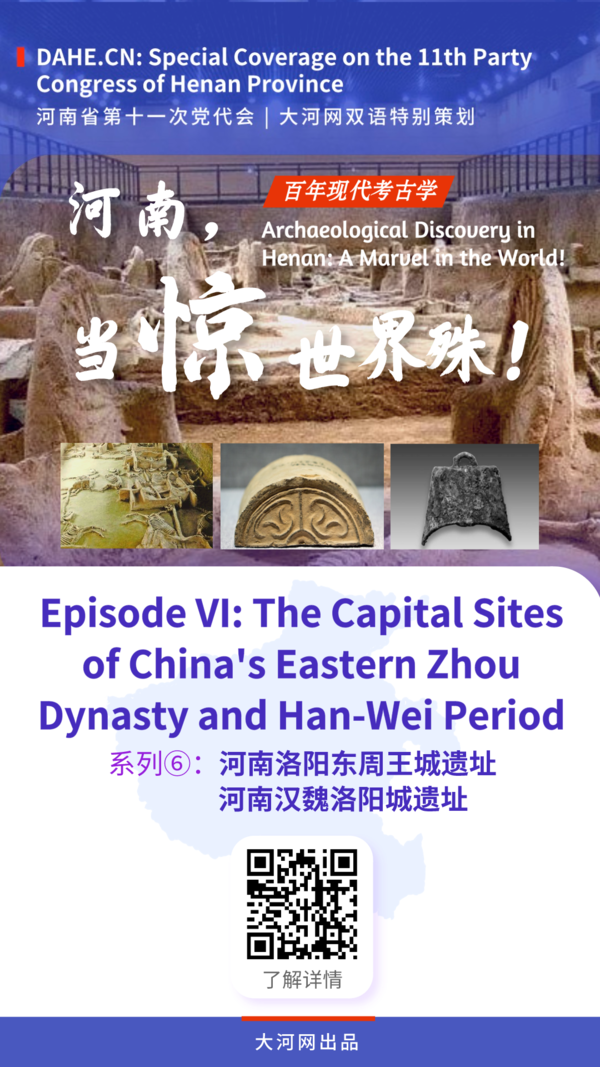Special Coverage on Party Congress | Episode VI: The Capital Site of the Eastern Zhou Dynasty & The Capital Site of China's Han-Wei Period
Henan province has 14 items listed among the recent-concluded selection of "China's 100 Major Archaeological Discoveries in Last 100 Years", ranking 1st nationwide.
近日,河南14项考古遗址入选全国“百年百大考古发现”,数量居全国第一。
During the 11th Party Congress of Henan Province, we are launching the Archaeological Discovery in Henan: A Marvel in the World series featuring 7 bilingual stories about Henan's 14 items in "China's 100 Major Archaeological Discoveries in Last 100 Years" to demonstrate Henan's long history and rich culture.
为更好地向世界展示河南文化、中国精彩,在中国共产党河南省第十一次代表大会期间,大河网特推出双语特别策划——百年现代考古学·河南当惊世界殊。
Here is the 6th episode: The Capital Site of the Eastern Zhou Dynasty & The Capital Site of China's Han-Wei Period.
今日推出第⑥期:《河南洛阳东周王城遗址 河南汉魏洛阳城遗址》。
Click on the video above
The Capital Site of the Eastern Zhou Dynasty in Luoyang
河南洛阳东周王城遗址
The Capital Site of the Eastern Zhou Dynasty is located in the area of today's Wangcheng Park of Luoyang city, Henan province.
洛阳东周王城,位于今洛阳市王城公园一带,为东周时期的古城遗址。

The remains of 6-horse chariot. [Photo provided to Henan Daily]
The site of the capital of the Eastern Zhou Dynasty is basically square in shape and about 15 kilometers in circumference with city walls (including 3 corners) on all sides. The majority of the site is located in the mid-western area of Luoyang's Xigong district, covering an area of about 9 square kilometers. The city walls were first built in the mid Spring and Autumn Period and maintained for several times in the Warring States Period, Qin and Han dynasties. In the site's southwestern area the palace remains were discovered, core of the capital, while in its northeastern area found a zone for making pottery wares. Besides, to the east of the building foundations in the site's southwestern area and to the northeast of Qujiatun village more than 80 pits for storing grains were discovered. At the same time, outside the city site the remains of large courier station-like buildings were also found.
洛阳东周王城平面大体呈正方形,整个王城周长约15公里,有四面城垣和三个城角,大部分位于西工区中西部,面积约9平方公里。城墙始建于春秋中期,战国至秦汉时曾多次修补。城址核心建筑物的宫殿群落位于城内的西南隅。考古人员在城址西北部发现了东周时期烧制陶器的区域;在西南隅建筑群基址东侧、瞿家屯村东北,共探出粮窖80余座;同时,在城外还发现了大型的馆驿性质的建筑遗迹。
The Capital Site of the Eastern Zhou Dynasty provided valuable physical evidence for the study of the politics, economy and culture of the Zhou Dynasty. Besides, the well-preserved remains of 6-horse chariot presented new evidence to study the etiquette and funeral systems at that time, becoming one of the major findings of the Eastern Zhou Dynasty during the 21st century.
洛阳东周王城遗址的发现,为研究周代政治、经济、文化提供了珍贵的实物资料,其中,“天子驾六”保存完好、规模宏大,对研究东周时期的乘舆制度和丧葬制度提供了全新的考古资料,成为21世纪东周考古的重要发现之一。
In May 2013, the Capital Site of the Eastern Zhou Dynasty was listed among the seventh group of major historical and cultural sites protected at the national level in China.
2013年5月,洛阳东周王城被国务院核定公布为第七批全国重点文物保护单位。
The Capital Site of China's Han-Wei Period in Luoyang
河南汉魏洛阳城遗址
The Capital Site of China's Han-Wei Period in Luoyang is 15 kilometers east of the city's Luolong district.
汉魏洛阳故城,位于河南省洛阳市洛龙区城东15公里,是汉魏时期的都城遗址。

The Capital Site of China's Han-Wei Period in Luoyang. [Photo provided to Henan Daily]
It was first built in the Western Zhou Dynasty and used until the early Tang Dynasty. The central axis at the site was an innovation, which influenced the layout design of the subsequent capitals for thousands of years. Covering an area of almost 100 square kilometers, the site consists of three parts, including imperial city, inner city and outer city. Such a large area makes it one of the largest ancient capitals in China and even the world.
汉魏洛阳城始建于西周,先后经历了东周至北魏等多个时代,到初唐方才废止。其中轴线的萌芽和形成,是都城规划发生的一次转折性变化,影响后代都城规划长达千年,在中国都城建设史上有着承前启后的重大意义。汉魏洛阳城分为宫城、内城和外郭城三重城圈,总面积近100平方公里。如此规模,使汉魏洛阳故城成为中国甚至世界历史上最大的古代都城之一。
The Capital Site of China's Han-Wei Period in Luoyang was not only a capital in the Eastern Han Dynasty, the Kingdom of Wei (the most powerful kingdom of the Three Kingdoms Period), the Western Jin Dynasty and the Northern Wei Dynasty, but also the most important international trade metropolis in the eastern end of the Silk Road, as a starting point of the Silk Road in the East.
汉魏洛阳故城不仅是东汉、曹魏、西晋和北魏时期的都城和全国的政治、经济、文化、军事统治中心,也是这一时期丝绸之路东端最重要的国际性商贸大都市,即丝绸之路的东方起点。
In 1961, the Capital Site of China's Han-Wei Period in Luoyang was listed among the first group of major historical and cultural sites protected at the national level in China.
1961年,国务院公布汉魏洛阳故城为第一批全国重点文物保护单位。(来源:大河网 编译:赵汉青 视频/海报:王君艺 审校:李文竞)

Related reports
Special Coverage on Party Congress | Episode I: The Jiahu Site & The Peiligang Site
【党代会双语特别策划】百年现代考古学·河南当惊世界殊 | 系列①:河南舞阳贾湖遗址 河南新郑裴李岗遗址
Special Coverage on Party Congress | Episode II: The Yangshao Site & The Miaodigou Site
【党代会双语特别策划】百年现代考古学·河南当惊世界殊 | 系列②:河南渑池仰韶村遗址 河南三门峡庙底沟遗址
Special Coverage on Party Congress | Episode III: The Shuanghuaishu Site & The Erlitou Site
【党代会双语特别策划】百年现代考古学·河南当惊世界殊 | 系列③:河南巩义双槐树遗址 河南偃师二里头遗址
【党代会双语特别策划】百年现代考古学·河南当惊世界殊 | 系列④:河南偃师商城遗址 河南郑州商城遗址
【党代会双语特别策划】百年现代考古学·河南当惊世界殊 | 系列⑤:河南安阳殷墟(含洹北商城、后冈遗址) 河南三门峡虢国墓地
【党代会双语特别策划】百年现代考古学·河南当惊世界殊 | 系列⑦:河南隋唐洛阳城遗址 河南许昌白沙宋墓
